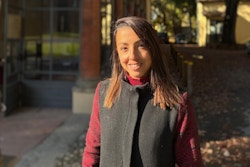For any readers who aren’t familiar with Una.Resin, can you briefly describe the project in your own words?
Emilio: If I was to sum up Una.Resin in one sentence, I would say that it is Una Europa universities taking the first steps together towards more structured collaboration from the point of view of research.
Alessia: The most straightforward way to explain Una.Resin is that we are taking the first steps towards a common ecosystem for research and innovation [for the Una Europa alliance]. What we mean by an ecosystem is an environment that is barrier-free, where collaboration among researchers can really thrive. Staff can access new opportunities and improve their well-being, and really be connected to colleagues across the Una Europa partner universities.
There are three pillars leading us towards this barrier-free ecosystem: delivering a common R&I agenda; sharing our resources and infrastructure; and working on the development of human capital.
Your work in Una.Resin focuses on research infrastructures and resources. What are you aiming to achieve?
Alessia: The core aim of our work is to deliver a strategy and action plan that achieves a scenario in which infrastructure and resources are shared across the alliance.
We started with a very comprehensive mapping exercise: mapping infrastructures in the fields of Cultural Heritage and One Health – the two Una Europa Focus Areas we chose to focus our work package on. We also mapped the organisational and management models: financial resources, national frameworks, legal issues etc. To better understand the barriers to sharing research infrastructures and ways to overcome them, we consulted stakeholders – infrastructure managers and academics from the One Health and Cultural Heritage fields and the academic Self-Steering Committees – to hear in their own voices what their needs and their perspectives on the possible actions we could pursue for their benefit to create this more open and inter-connected ecosystem of infrastructure.
Regarding actions, we are already experimenting with some concrete pilot formats for opening and sharing infrastructures.
From listening to our stakeholders, we understand that there is a deep need to get in touch with each other, to know each other, to understand the resources and assets that are available in other universities, to exchange knowledge and best practice. We recognise that we have a long way to go to achieve this ambitious aim of a barrier-free ecosystem. This project is just the first step.
" From listening to our stakeholders, we understand that there is a deep need to get in touch with each other, to know each other, to understand the resources and assets that are available in other universities, to exchange knowledge and best practice. We recognise that we have a long way to go to achieve this ambitious aim of a barrier-free ecosystem. This project is just the first step. "
Alessia Franchini, Alma Mater Studiorum - Università di Bologna
You’re working on a blueprint for an alliance-wide research infrastructures catalogue. Can you explain why we need this?
Emilio: The blueprint for the common catalogue describes how we can create a tool that will enable Una Europa researchers to know what resources and infrastructures are available across the alliance and will facilitate cross-institutional access. This tool will also establish a deep understanding of what the alliance is. The alliance is made up of 11 universities, more than 500,000 students and 100,000 university staff. At the same time, the alliance has a critical mass of research infrastructures and resources. This dimension of the alliance is not immediately known. It's challenging to understand the scope and scale of resources and infrastructures even at a university level.
The catalogue will contribute to a better understanding of the alliance – and a better understanding of the possibilities offered by the alliance.
A common research infrastructures catalogue is the basis for all kinds of cooperation. It is useful for researchers from different partner universities to work together, to offer services to each other, or even offer services together to third parties – to cooperate on project proposals to secure more funding, for example. The list of benefits is long and not fully known. When we’re talking about research infrastructure, we’re talking about many things: core facilities, laboratories, databases and equipment that hold possibilities we can't even imagine.
We’re at the beginning of something – the beginning of a better understanding of the possibilities the alliance holds.
Una Europa’s R&I Strategy is currently in development. What impact do you hope the Strategy will achieve for researchers?
Alessia: I hope that the R&I Strategy will inspire researchers and convey a meaningful message to them: “Look, Una Europa is an alliance that is full of opportunities for you – for collaboration, for delivering excellent research, and for working in this barrier-free, collaborative environment."
I hope we will inspire researchers to see the added value of being part of the alliance so that they can really be excited to engage in alliance activities. Especially early-career researchers, who may have a higher need to develop and strengthen their network and their contacts. They are one of the main target groups in our strategy.
We also want to inspire professional staff. [Our vision for a common R&I ecosystem] is also for staff – research managers, data stewards, open science experts, librarians... All of them should all see the alliance as a box of opportunities that can help them to grow professionally and improve their well-being at work.
Alma Mater Studiorum - Università di Bologna co-leads Una.Resin Work Package 2: Una Europa Infrastructure & Resources with KU Leuven and Université Paris 1 Panthéon-Sorbonne. Learn more about Una.Resin.



